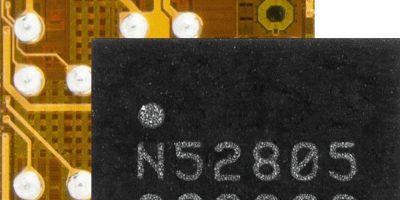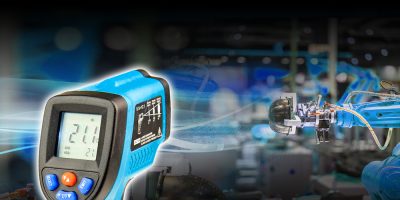Available in a wafer level chip scale package (WLCSP), optimised for compact, two-layer PCB wireless products, the nRF52805 SoC adds Bluetooth 5.2 to Nordic Semiconductor’s nRF52 series.
The nRF52805 SoC offers Bluetooth low energy (LE), high-throughput device can be used for cost-constrained applications such as disposable medical products, styluses, sensors, and beacons
The nRF52805 Bluetooth 5.2 SoC in a WLCSP measures just 2.48 x 2.46mm. The WLCSP SoC is optimised for two-layer PCB designs, avoiding the need for more expensive four-layer PCBs in compact, budget-constrained designs, says Nordic. The SoC is capable of Bluetooth LE high-throughput 2Mbits per second and enhanced Channel Selection Algorithm #2 (CSA #2) for improved co-existence.
Based on a 64MHz, 32bit Arm Cortex-M4 processor (144 CoreMark) with 65 CoreMark/mA efficiency, the SoC also includes 192kbyte flash memory and 24kbyte RAM. The multiprotocol (Bluetooth LE/2.4GHz) radio offers up to +4dBm power output and -97dBm sensitivity (1Mbits per second Bluetooth LE) for a link budget of 101dBm. The radio’s peak power draw is only 4.6mA (TX 0dBM, RX 1Mbits per second) and the SoC’s current draw is as low as 0.3 microA in system off and 1.1 microA in system on with 24kbyte RAM retained and real time clock (RTC) running. The SoC features a range of analogue and digital interfaces such as SPI, UART and two wire interface (TWI), a two-channel 12-bit ADC, and ten general purpose I/Os.
Nordic offers a 9.5 x 8.8mm reference layout with all ten general purpose I/Os available, which requires only 10 external passive components (including two crystal load capacitors).
The SoC can be powered from a 1.7 to 3.6V supply and integrates LDO and DC/DC voltage regulators.
The nRF52805 is currently supported by the S112 SoftDevice and Nordic confirms that support for the S113 SoftDevice follows soon. The S112 and S113 SoftDevices (Bluetooth 5.1-qualified protocol software) are memory-optimised peripheral stacks which support high-throughput 2Mbits per second and CSA #2 features. The stacks support up to four connections as a peripheral concurrently with a broadcaster.
The number of connections and bandwidth per connection is configurable, enabling memory and performance optimisation.
Both the S112 and S113 also support LE Secure Connections, improving security compared to LE Legacy Pairing. S113 also supports LE Data Packet Length Extension, resulting in higher throughput and less overhead per packet.
There is a guide explaining how to use the nRF52805 with Nordic’s nRF5 software development kit (SDK). Nordic recommends the nRF52 development kit can be used to emulate the nRF52805 and is a good hardware basis to start designs before moving over to a custom development board.
The nRF52805 is now in volume production.






